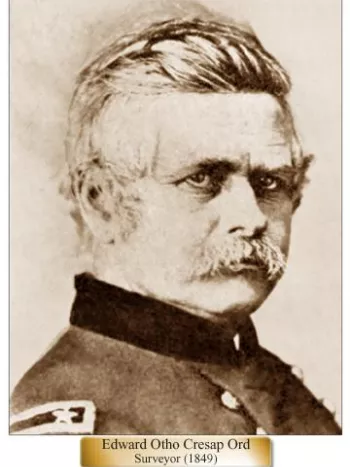
The Ord Survey
As a Pueblo in 1781 Los Angeles was never surveyed, it was measured by varas (33 inches) and leagues (2.6 miles to a league). Then, like a famous moppet in American Literature, Los Angeles "just growed" unfortunately without a plan or a formal survey to exactly locate public and private property lines.
In time, adobes became isolated or stranded in the middle of a hodge podge of streets and owners in 1854 were granted the right by the Common Council to claim a right of way to the thoroughfare nearest their houses.
This developed into an intolerable situation as described by Harris Newmark in his "Sixty years in Southern California" streets came into being without any provisions for maintenance.
Graded streets and sidewalks were unknown: hence, after heavy winter rains mud was from six inches to two feet deep, while during the summer, dust piled up to about the same extent. Few city ordinances were obeyed; for notwithstanding that a regulation of the City Council called on every citizen to sweep in front of his house to a certain point on Saturday evenings not the slightest attention was paid to it. Into the roadway was thrown all the rubbish: if a man bought a new suit of clothes, a pair of boots, a hat or a shirt, to replace a corresponding part of his apparel that had outlived its usefulness, he would think nothing, on attiring himself in the new purchase, of tossing the discarded article into the street where it would remain until some passing Indian, or other vagabond, took possession of it. So wretched indeed were the conditions, that I have seen dead animals left on the highways for days at a time, and can recall one instance of a horse dying on Alameda Street and lying there until a party of Indians cut up the carcass for food. What made these street conditions more trying was the fact that on hot days roads and sidewalks were devoid of shade, except for that furnished by a few scattered trees or an occasional projecting veranda; while at night (if I except the illumination from the few lanterns suspended in front of barrooms and stores) thoroughfares were altogether unlighted. In those nights of dark streets and still darker tragedies, people rarely went out unless equipped with candle burning lanterns, at least until camphine was imported by my brother, after which this was brought into general use. Stores were lighted in the same manner: first with candles, then with camphine and finally with coal oil, during which period of advancement lamps replaced the cruder contrivances."
In 1849, because City Officials needed funds for the Pueblo and the selling of lots without knowing exact boundaries could lead to litigation, a survey was deemed essential. Lt. E.O.C. Ord was hired to run the survey for $3,000. He was assisted by William Rich Hutton along with three other persons hired to assist as chain and signal bearers. The survey was completed in August 1849, but at best it was more of a loosely compiled approximation than a survey.
Los Angeles residents were to observe that the Ord Survey contracted in order to bring order out of the Pueblo chaos, served only to leave even greater confusion.